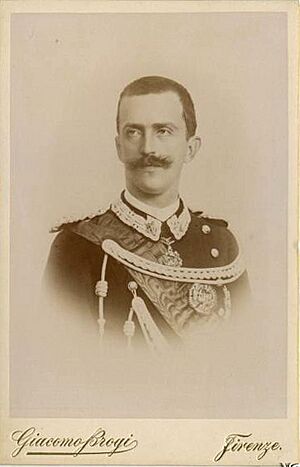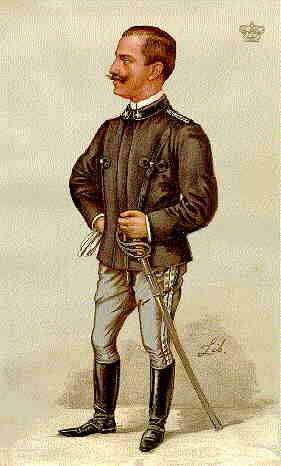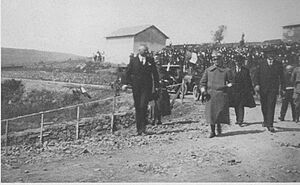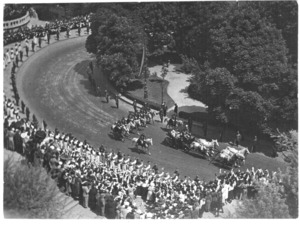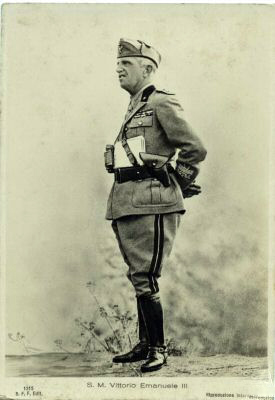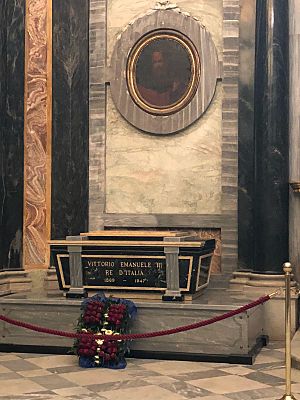Victor Emmanuel III of Italy facts for kids
Quick facts for kids Victor Emmanuel III |
|||||
|---|---|---|---|---|---|
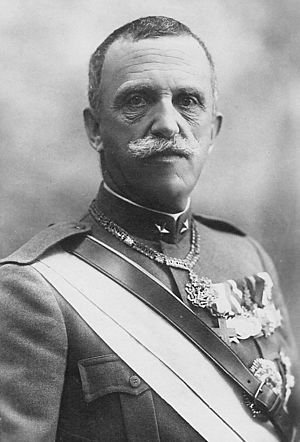
Victor Emmanuel in 1919
|
|||||
| King of Italy | |||||
| Reign | 29 July 1900 – 9 May 1946 | ||||
| Predecessor | Umberto I | ||||
| Successor | Umberto II | ||||
| Prime ministers | See list | ||||
| Emperor of Ethiopia | |||||
| Reign | 9 May 1936 – 5 May 1941 | ||||
| Predecessor | Haile Selassie I | ||||
| Successor | Haile Selassie I | ||||
| King of the Albanians | |||||
| Reign | 16 April 1939 – 8 September 1943 | ||||
| Predecessor | Zog I | ||||
| Successor | Zog I (formally) | ||||
| Prime ministers | See list | ||||
| Born | 11 November 1869 Naples, Kingdom of Italy |
||||
| Died | 28 December 1947 (aged 78) Alexandria, Kingdom of Egypt |
||||
| Burial | Sanctuary of Vicoforte, Vicoforte, Italy | ||||
| Spouse | |||||
| Issue |
|
||||
|
|||||
| House | Savoy | ||||
| Father | Umberto I of Italy | ||||
| Mother | Margherita of Savoy | ||||
| Signature | |||||
Victor Emmanuel III (born 11 November 1869 – died 28 December 1947) was the King of Italy for almost 46 years. He ruled from 1900 until he gave up his throne in 1946. He also held the titles of Emperor of Ethiopia (1936–1941) and King of the Albanians (1939–1943).
His long reign began after his father, King Umberto I, was assassinated. During this time, Italy went through major changes. The country was involved in both World War I and World War II. His rule also saw the rise and fall of Italian fascism in Italy.
The early years of his reign focused on making Italy more modern and democratic. Italy also gained new lands overseas. However, after World War I, the country faced many problems. This led to the rise of Benito Mussolini and the Fascist party. The King appointed Mussolini as prime minister.
Victor Emmanuel III did not speak out against the Fascist government's actions. He accepted new titles as Emperor of Ethiopia and King of Albania as Italy expanded its empire. When World War II started, he first advised against Italy joining the war. But he later allowed Mussolini to lead Italy into the conflict.
In 1943, as the Allies invaded Italy, Victor Emmanuel III removed Mussolini from power. He then signed a peace agreement with the Allies. To escape German forces, he and his government moved south. He later declared war on Germany. In 1944, he gave most of his powers to his son, Umberto. In 1946, he officially stepped down as king, hoping to save the monarchy. However, Italians voted to become a republic. He then went to live in Alexandria, Egypt, where he died. In 2017, his remains were brought back to Italy.
People sometimes called him Sciaboletta ("little saber") because he was only about 1.53 meters (5 feet) tall. He was also known as il Re soldato (the Soldier King) for leading Italy during two world wars.
Contents
Early Life of Victor Emmanuel III

Victor Emmanuel III was born in Naples, Italy. His parents were King Umberto I and Margherita of Savoy, the Queen. He was named after his grandfather, Victor Emmanuel II, who was also a King of Italy.
Unlike some of his taller relatives, Victor Emmanuel was quite short. He was only about 1.53 meters (just over 5 feet) tall. Before he became king, he was known as The Prince of Naples.
In 1896, Prince Victor Emmanuel married Princess Elena of Montenegro.
Becoming King of Italy
Taking the Throne
Victor Emmanuel became king on 29 July 1900, when he was 30 years old. This happened after his father was assassinated. His father had once told him that to be a king, he only needed to know how to sign his name, read a newspaper, and ride a horse.
In his early years as king, Victor Emmanuel showed he believed in a government guided by a constitution. Even though an anarchist killed his father, the new king supported people's freedoms.
Italy had a parliament, but the king still had important powers. For example, he could choose the prime minister, even if that person did not have the support of most lawmakers. The King was a shy person and did not like the daily stress of politics. However, Italy's unstable government often made him step in to solve problems.
Italy in World War I
When World War I began, Italy first stayed neutral. This was despite being part of the Triple Alliance with Germany and Austria. However, in April 1915, Italy secretly signed the Treaty of London. This agreement committed Italy to join the war on the side of the Triple Entente (Britain, France, and Russia).
Most politicians did not want to go to war. The Italian parliament even forced the Prime Minister to resign. But Victor Emmanuel refused his resignation. He personally decided that Italy would enter the war. He had the right to do this under the country's constitution.
People held demonstrations in Rome to support the war. However, Italy's war effort was not well organized. There were many deaths in the army, especially after the big defeat at Caporetto. This, along with economic problems after the war, made the King unhappy with the politicians.
Despite these issues, the King visited areas in northern Italy that were being attacked. He showed great courage and care for his people. His wife, the Queen, also helped nurses care for wounded soldiers. During World War I, the King was genuinely liked by most Italians.
Victor Emmanuel and Fascism
Supporting Mussolini's Rise
After World War I, Italy faced economic hardship. This led to extreme political groups gaining power. Benito Mussolini, who would soon become Italy's Fascist dictator, used this instability to rise to power.
The March on Rome
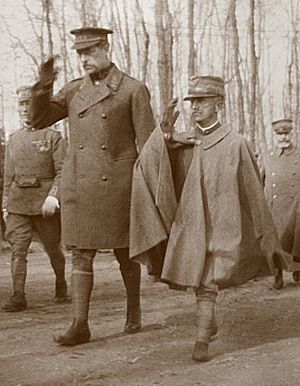
In 1922, Mussolini led his Fascist supporters in a march on Rome. The Prime Minister and his government wanted to declare martial law to stop them. But the King refused to sign the order. He worried that the army might not be able to stop the uprising without causing a civil war.
Fascist violence had been increasing. On 24 October 1922, Mussolini announced that the Fascists would march on Rome. A general told the King that the army could easily defeat the Fascists. The Fascists had only about 10,000 men, mostly with knives and clubs. The army had 30,000 soldiers in Rome with heavy weapons.
The army was loyal to the King. Even a Fascist leader involved in the March on Rome told Mussolini he would not act against the King's wishes. But then, the King sent a telegram inviting Mussolini to Rome. The Prime Minister was surprised when the King refused to sign the martial law order. The King said it was his royal right and he did not want to use force against the Fascists.
On 30 October, Mussolini was appointed Prime Minister. He was 39 years old and had no previous government experience. He had only 32 Fascist lawmakers in parliament. The King later said he acted out of fear of civil war. However, it seems he was advised to make a deal with Mussolini.
On 1 November 1922, the King watched the Fascist groups march past his palace. Victor Emmanuel did not take responsibility for appointing Mussolini. He said that historical events were "more automatic" than the result of individual actions. He was tired of the constant political problems and saw Mussolini as a "strong man" who could bring "order" to Italy. Mussolini was always respectful to the King in private. The King liked that Mussolini, who had once been against monarchy, now supported it.
Building the Fascist Dictatorship
The King did not act against the Mussolini government's abuses of power. This included the murder of a lawmaker, Giacomo Matteotti, in 1924. Many people in Italy turned against Fascism after this event. The King could have removed Mussolini then, with public support. But he did not.
Victor Emmanuel remained silent when Mussolini ended democracy in 1925–26. The King signed laws that removed freedom of speech, assembly, and the press. The Fascist Party became the only legal party. In December 1925, Mussolini passed a law saying he was responsible only to the King, not to Parliament. The King agreed to these changes.
By 1928, the King's power to dismiss Mussolini was almost the only check on the dictator. Even this power could only be used with the advice of the Fascist Grand Council, which Mussolini controlled.
The King's actions showed weakness. This had serious consequences for Italy and for the monarchy itself. Victor Emmanuel saw Socialists and Communists as his main enemies. He felt that Mussolini's dictatorship saved the existing system in Italy. The King always returned the Fascist salute. He also honored Fascist "martyrs" who died fighting against Socialists and Communists. However, the monarchy became so linked with Fascism that it was too late to save it when the King finally tried to break free.
Victor Emmanuel did not like what he called the "superficiality" of Rome's high society. He preferred to spend his time hunting, fishing, and reading military history books in the countryside. He was a quiet man who found it hard to talk to people. He was happy to let Mussolini rule Italy, as it saved him from meeting many politicians.
Lateran Treaty
Victor Emmanuel did not like the Catholic Church because it refused to recognize Rome as Italy's capital. But he knew that a treaty with the Vatican was needed. This was because many Italians would not see the Italian state as legitimate otherwise.
In 1926, the King allowed Mussolini to start talks with the Vatican. In 1929, Mussolini signed the Lateran Treaty on behalf of the King. This treaty settled the "Roman Question" and recognized Vatican City as an independent state.
Public Support and New Titles
The Italian monarchy was popular for many years. Even in the 1930s, people would applaud when they saw images of King Victor Emmanuel and Queen Elena in newsreels. This was different from the silence given to Fascist leaders.
In 1938, the Italian Parliament created a new top military rank, First Marshal of the Empire, for both Victor Emmanuel and Mussolini. The King saw this as an insult. He felt it was a sign that the Fascists wanted to get rid of him eventually.
Despite his popularity, some of Victor Emmanuel's decisions harmed the monarchy. These included taking the title of Emperor of Ethiopia, staying silent when Mussolini's government passed racial laws, and taking the crown of Albania.
Colonial Expansion
Emperor of Ethiopia
In 1936, Victor Emmanuel became Emperor of Ethiopia. He took this title after the Italian Army invaded Ethiopia (Abyssinia) and removed Emperor Haile Selassie during the Second Italo-Ethiopian War.
Ethiopia became part of the Italian Empire. The League of Nations (an international organization) condemned Italy's actions. Some major countries, like the United States, did not accept Italy's claim to Ethiopia. However, Britain and France accepted it in 1938. Italy lost control of Ethiopia in 1943. In November 1943, Victor Emmanuel gave up his claims to the titles of Emperor of Ethiopia and King of Albania.
King of the Albanians
Victor Emmanuel also became the King of the Albanians in 1939. This happened when Italian forces invaded Albania. The Albanian King, Zog I, had to flee.
In 1941, while in Tirana, the King survived an assassination attempt by an 18-year-old Albanian.
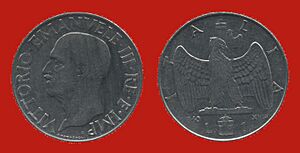
World War II and the Fall of Fascism
Pact with Germany
Italy signed the Pact of Steel with Germany in May 1939. This was an alliance that meant Italy should follow Germany into war. Germany told Mussolini there would be no war until 1942 or 1943. But the Italian ambassador in Berlin warned that Hitler planned to start a war sooner.
In August 1939, Italy's Foreign Minister learned that Germany would invade Poland that summer. Mussolini was ready to join the war in 1939, but Victor Emmanuel stopped him. The King said Italy was "absolutely in no condition to wage war." He also said that as supreme commander, he wanted to be involved in any "supreme decisions" about war. This meant he could stop Mussolini from going to war.
Italy declared neutrality in September 1939. However, Mussolini always wanted to join Germany in the war. He believed Italy could gain a lot from it. Victor Emmanuel had strong doubts about going to war. He even thought about dismissing Mussolini in March 1940. The King hoped that the Fascist Grand Council would vote against joining the war.
Joining the Axis Powers
Victor Emmanuel was a careful man. He always asked his military advisors for their opinions. They told him that Italy's military was not ready. But as Germany advanced into France in May 1940, the King's opposition to war began to weaken. Mussolini argued that Germany was winning, and Italy had a chance to gain land from France and Britain.
On 1 June 1940, Victor Emmanuel finally gave Mussolini permission for Italy to enter the war. The King kept the supreme command, giving Mussolini power only over political and military questions.
On 10 June 1940, Italy entered World War II on the side of Nazi Germany. This was a bad decision, as Italy was not prepared. From the start, there were many disasters. Italy's first attack on France failed. Italian armies in North Africa and Greece suffered humiliating defeats in 1940 and 1941.
The King was kept informed about public opinion. From late 1940, he received reports that the war and the Fascist government were becoming very unpopular. In January 1941, the King admitted that the war was not going well. But he decided to keep Mussolini as prime minister because he saw no one else to replace him. He feared that overthrowing Fascism would mean the end of the monarchy.
In December 1941, Victor Emmanuel agreed to Mussolini's request to declare war on the United States. He believed the Americans would focus on Japan, not Europe. The King was pleased when Japan entered the war, hoping it would force Britain to move its forces to Asia.
The King often avoided making difficult decisions. He also respected Mussolini and saw him as his most capable prime minister. He seemed to fear taking on a man he believed was more intelligent than himself. The Vatican wanted Italy to leave the war by 1943. But papal diplomats said the King was "weak, indecisive and excessively devoted to Mussolini."
Losing Faith in Mussolini
By the summer of 1942, many Fascist leaders hoped the King would remove Mussolini to save the Fascist government. In late 1942, Italy lost Libya. In early 1943, Italian forces in Russia were defeated. By mid-1943, Italian forces in Tunisia surrendered, and the Allies took Sicily. The Italian Navy was mostly stuck in port due to lack of fuel and defeats. The Air Force did better but lacked modern planes.
Efforts to Save the Monarchy
As Italy's situation worsened, the King's popularity dropped. People started to blame him for the war.
By early 1943, Mussolini was very depressed by Italy's defeats. On 15 May 1943, the King sent Mussolini a letter saying Italy should sign a peace agreement and leave the war. The King also secretly contacted the British and American governments through the Vatican. He asked if they would allow the House of Savoy to continue ruling after the war.
On 19 July 1943, Rome was bombed for the first time. This made Italians even more unhappy with their King. When the King visited the bombed areas, people booed him loudly. This made Victor Emmanuel worry about a revolution that might create a republic.
The King wanted to keep the Fascist system going after removing Mussolini. He chose Marshal Pietro Badoglio as Mussolini's replacement. Badoglio had served Mussolini loyally but had a grudge against him. The King believed Badoglio would obey his orders.
Removing Mussolini from Power
On the night of 25 July 1943, the Grand Council of Fascism voted to ask Victor Emmanuel to take back his full powers. This was a vote of no confidence in Mussolini.
The next day, Mussolini met the King. Victor Emmanuel told him he was dismissing him as Prime Minister and replacing him with Marshal Badoglio. He then ordered Mussolini's arrest. The King had been planning this move for some time.
Publicly, Victor Emmanuel and Badoglio said Italy would continue the war with Germany. But secretly, they began talking with the Allies about a peace agreement. The King's generals advised him to sign an immediate peace deal. They said the time was right because there were fewer German troops in Italy than Italian troops.
However, Victor Emmanuel did not want to accept the Allied demand for unconditional surrender. He wanted guarantees that he would keep his throne and that Italy would get back its colonies. These demands were unrealistic and delayed the peace talks. Meanwhile, German forces continued to pour into Italy.
Peace with the Allies
On 8 September 1943, Victor Emmanuel publicly announced a peace agreement with the Allies. This caused confusion among Italian forces, who were left without orders. The Germans, who expected this, quickly disarmed Italian troops and took control of Italy and other areas. Many Italian units that did not surrender joined the Allies against the Germans.
Fearing a German attack on Rome, Victor Emmanuel and his government fled south to Brindisi. This was likely necessary for his safety, as Hitler had planned to arrest him. However, many people were surprised by his flight. People compared him unfavorably to King George VI and Queen Elizabeth, who stayed in London during the bombings, and to Pope Pius XII, who stayed with the people in Rome.
Despite the German occupation, Victor Emmanuel refused to declare war on Germany. He said he needed a vote from Parliament first. But he had not needed Parliament's vote to declare war on other countries before. Under pressure from the Allies, the King finally declared war on Germany on 8 October 1943.
The Badoglio government in southern Italy formed new forces loyal to the King. However, relations with the Allies were difficult. Victor Emmanuel was very concerned with proper procedures. He complained when an Allied general met him wearing shorts. He also criticized the slow progress of the Allied armies fighting their way up Italy. He wanted to return to Rome quickly.
On 12 September, the Germans rescued Mussolini from captivity. Mussolini then set up a new Fascist state in northern Italy, called the Italian Social Republic. This was a puppet state controlled by Germany.
By this time, it was clear that Victor Emmanuel was too closely linked to the Fascist government. In April 1944, under pressure from Allied officials, Victor Emmanuel gave most of his powers to his son, Crown Prince Umberto. He privately told an Allied general that by doing this, the Allies were giving power to the Communists.
After Rome was freed on 4 June, he gave his remaining powers to Umberto. He named Umberto Lieutenant General of the Realm, while still technically remaining King.
After the War and the End of the Monarchy
Giving Up the Throne
After the war, public opinion led to a vote on whether Italy should remain a monarchy or become a republic. To help the monarchy, Victor Emmanuel officially gave up his throne to his son. Umberto II became King on 9 May 1946.
Monarchy Abolished
This move did not work. In the vote held a month later, 54 percent of voters chose a republic. The Kingdom of Italy came to an end. Some historians believe the result might have been different if Victor Emmanuel had given up his throne earlier. Umberto had been praised for his role as acting head of state since 1944. His popularity might have saved the monarchy.
Exile and Death
After the vote, Victor Emmanuel and all other male members of the House of Savoy had to leave Italy. He went to Egypt, where King Farouk welcomed him. Victor Emmanuel died in Alexandria a year later. He was buried in St Catherine's Cathedral.
Return to Italy in 2017
On 17 December 2017, Victor Emmanuel III's remains were officially brought back to Italy by a military plane. They were moved from Alexandria to the sanctuary of Vicoforte, near Turin. His wife Elena's remains had been moved there two days earlier.
Legacy
The King's decision to give up the throne just before the vote reminded people of the monarchy's role during the Fascist period. This likely hurt the chances of the monarchy surviving.
Victor Emmanuel III was a very active coin collector. He gathered about 100,000 coins from different periods of Italian history. When he gave up his throne, he donated most of his collection to the Italian people. The coins of the House of Savoy, which he took with him, were later added to the collection in the National Museum of Rome after his son's death. Between 1910 and 1943, Victor Emmanuel wrote a 20-volume book called Corpus Nummorum Italicorum, which listed all the coins in his collection.
After World War I, a street in Paris was named Avenue Victor-Emmanuel III to honor Italy's alliance. But after his support for the Axis Powers in World War II, the street was renamed Franklin D. Roosevelt Avenue in 1946.
Honors and Family
National Awards
 Kingdom of Italy:
Kingdom of Italy:
- Knight of the Annunciation, 1887
- Grand Cross of Saints Maurice and Lazarus, 1887
- Grand Cross of the Crown of Italy, 1887
 Italian Albania:
Italian Albania:
- Sovereign of the Order of Besa, 1939-1943
- Sovereign of the Order of Skanderbeg, 1939-1943
Foreign Awards
 Denmark: Knight of the Elephant, 1891
Denmark: Knight of the Elephant, 1891 Empire of Japan: Collar of the Order of the Chrysanthemum, 1902
Empire of Japan: Collar of the Order of the Chrysanthemum, 1902- Spain:
 Kingdom of Spain: Knight of the Golden Fleece, 1878
Kingdom of Spain: Knight of the Golden Fleece, 1878

 Sweden-Norway: Knight of the Seraphim, 1888
Sweden-Norway: Knight of the Seraphim, 1888 United Kingdom: Stranger Knight of the Garter, 1891 (removed in 1941)
United Kingdom: Stranger Knight of the Garter, 1891 (removed in 1941) Vatican City:
Vatican City:  Holy See: Knight of the Supreme Order of Christ, 1932
Holy See: Knight of the Supreme Order of Christ, 1932
His Children
In 1896, he married Princess Elena of Montenegro. They had five children:
- Yolanda Margherita Milena Elisabetta Romana Maria (1901–1986)
- Mafalda Maria Elisabetta Anna Romana (1902–1944), who died in the Nazi concentration camp at Buchenwald.
- Umberto Nicola Tommaso Giovanni Maria, who later became Umberto II, King of Italy (1904–1983).
- Giovanna Elisabetta Antonia Romana Maria (1907–2000), who married King Boris III of Bulgaria.
- Maria Francesca Anna Romana (1914–2001).
Images for kids
See also
 In Spanish: Víctor Manuel III de Italia para niños
In Spanish: Víctor Manuel III de Italia para niños


